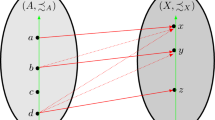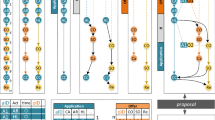Abstract
This paper discusses a timed variant of a process algebra akin to LOTOS, baptized UPA, in a causality-based setting. Two timed features are incorporated—a delay function which constrains the occurrence time of atomic actions and an urgency operator that forces (local or synchronized) actions to happen urgently. Timeouts are typical urgent phenomena. A novel timed extension of event structures is introduced and used as a vehicle to provide a denotational causality-based semantics for UPA. Recursion is dealt with by using standard fixpoint theory. In addition, an operational semantics is presented based on separate time- and action-transitions that is shown to be consistent with the event structure semantics. An interleaving semantics for UPA is immediately obtained from the operational semantics. By adopting this dual approach the well-developed timed interleaving view is extended with a consistent timed partial order view and a comparison is facilitated of the partial order model and the variety of existing (interleaved) timed process algebras.
Similar content being viewed by others
References
S. Abramski. Observation equivalence as a testing equivalence. Theoretical Computer Science, 53:225–241, 1987.
J.C.M. Baeten and J.W. Klop, editors. Concur '90: Theories of Concurrency — Unification and Extension, volume 458 of Lecture Notes in Computer Science. Springer-Verlag, 1990.
J.C.M. Baeten and W.P. Weijland. Process Algebra, volume 18 of Cambridge Tracts in Theoretical Computer Science. Cambridge University Press, 1990.
C. Baier and M.E. Majster-Cederbaum. The connection between an event structure semantics and an operational semantics for TCSP. Acta Informatica, 31:81–104, 1994.
T. Bolognesi and E. Brinksma. Introduction to the ISO specification language LOTOS. Computer Networks and ISDN Systems, 14:25–59, 1987.
T. Bolognesi and F. Lucidi. Timed process algebras with urgent interactions and a unique powerful binary operator. In de Bakker et al., editors, Real-time: Theory in Practice, volume 600 of Lecture Notes in Computer Science. Springer-Verlag, pages 124–148, 1992.
T. Bolognesi, F. Lucidi, and S. Trigila. Converging towards a timed LOTOS standard. Computer Standards & Interfaces, 16:87–118, 1994.
G. Boudol and I. Castellani. Flow models of distributed computations: three equivalent semantics for CCS. Information and Computation, 114:247–314, 1994.
H. Bowman. A true concurrency approach to time extended LOTOS (revised version). Technical Report 17–96, University of Kent at Canterbury, 1996.
E. Brinksma, J-P. Katoen, R. Langerak, and D. Latella. Performance analysis and true concurrency semantics. In T. Rus and C. Rattray, editors, Theories and Experiences for Real-Time System Development. World Scientific,, pages 309–337, 1994.
E. Brinksma, J-P. Katoen, R. Langerak, and D. Latella. A stochastic causality-based process algebra. The Computer Journal, 38:552–565, 1995.
R.T. Casley, R.F. Crew, J. Meseguer, and V.R. Pratt. Temporal structures. Mathematical Structures in Computer Science, 1:179–213, 1991.
P. Degano, R. De Nicola, and U. Montanari. On the consistency of 'truly concurrent' operational and denotational semantics (extended abstract). In Third Annual Symposium on Logic in Computer Science. IEEE Computer Society Press, pages 133–141, 1988.
C.J. Fidge. A constraint-oriented real-time process calculus. In Diaz and Groz, editors, Formal Description Techniques V, volume C-10 of IFIP Transactions. North-Holland, pages 363–378, 1993.
E. Goubault. Durations for truly-concurrent transitions. In H.R. Nielson, editor, Programming Languages and Systems — ESOP'96, volume 1058 of Lecture Notes in Computer Science. Springer-Verlag, pages 173–188, 1996.
J. Gunawardena. A dynamic approach to timed behaviour. In B. Jonsson and J. Parrow, editors, Concur' 94: Concurrency Theory, volume 836 of Lecture Notes in Computer Science. Springer-Verlag, pages 178–193, 1994.
C.A.R. Hoare. Communicating Sequential Processes. Prentice-Hall, 1985.
W. Janssen, M. Poel, Q. Wu, and J. Zwiers. Layering of real-time distributed processes. In H. Langmaack, W.-P. de Roever, and J. Vytopil, editors, Formal Techniques in Real-Time and Fault-Tolerant Systems, volume 863 of Lecture Notes in Computer Science. Springer-Verlag, pages 393–417, 1994.
A.S.A. Jeffrey, S. Schneider, and F.W. Vaandrager. A comparison of additivity axioms in timed transition systems. Technical Report CS-R9366, Centre for Mathematics and Computer Science, 1993.
J-P. Katoen. Quantitative and Qualitative Extensions of Event Structures. PhD thesis, University of Twente, CTIT Ph. D-thesis series No. 96-09, 1996.
J-P. Katoen, R. Langerak, and D. Latella. Modelling systems by probabilistic process algebra: An event structures approach. In R.L. Tenney, P.D. Amer, and M.Ü. Uyar, editors. Formal Description Techniques VI, volume C-22 of IFIP Transactions. North-Holland, pages 253–268, 1994.
J-P. Katoen, D. Latella, R. Langerak, and E. Brinksma. On specifying real-time systems in a causality-based setting. In B. Jonsson and J. Parrow, editors, Formal Techniques in Real-Time and Fault-Tolerant Systems, volume 1135 of Lecture Notes in Computer Science. Springer-Verlag, pages 385–405, 1996.
R. Langerak. Bundle event structures: a non-interleaving semantics for LOTOS. In Diaz and Groz, editors, Formal Description Techniques V, volume C-10 of IFIP Transactions. North-Holland, pages 331–346, 1993.
R. Loogen and U. Goltz. Modelling nondeterministic concurrent processes with event structures. Fundamenta Informaticae, 14:39–74, 1991.
N.A. Lynch and F.W. Vaandrager. Action transducers and timed automata. In W.R. Cleaveland, editor, Concur '92, volume 630 of Lecture Notes in Computer Science. Springer-Verlag, pages 436–455, 1992.
A. Maggiolo-Schettini and J. Winkowski. Towards an algebra for timed behaviours. Theoretical Computer Science, 103:335–363, 1992.
R. Milner. Communication and Concurrency. Prentice-Hall, 1989.
F. Moller and C. Tofts. A temporal calculus of communicating systems. In Baeten and Klop, editors, Concur '90: Theories of Concurrency — Unification and Extension, volume 458 of Lecture Notes in Computer Science. Springer-Verlag, pages 401–415, 1990.
D.V.J. Murphy. Time and duration in noninterleaving concurrency. Fundamenta Informaticae, 19:403–416, 1993.
X. Nicollin and J. Sifakis. An overview and synthesis on timed process algebras. In de Bakker et al., editors, Real-time: Theory in Practice, volume 600 of Lecture Notes in Computer Science. Springer-Verlag, pages 526–548, 1992.
M. Nielsen, G.D. Plotkin, and G. Winskel. Petri nets, event structures and domains, part 1. Theoretical Computer Science, 13:85–108, 1981.
G.M. Pinna and A. Poigné. On the nature of events: another perspective in concurrency. Theoretical Computer Science, 138:425–454, 1995.
G.D. Plotkin. A structural approach to operational semantics. Technical Report DAIMI FN-19, Computer Science Department, Aarhus University, 1981.
D.A. Schmidt. Denotational Semantics: a methodology for language development. Allyn and Bacon, 1986.
S. Schneider. An operational semantics for timed CSP. Information and Computation, 116:193–213, 1995.
C.A. Vissers. FDTs for open distributed systems, a retrospective and a prospective view. In L. Logrippo, R.L. Probert, and H. Ural, editors, Protocol Specification, Testing and Verification X. North-Holland, pages 341–362, 1990.
Y. Wang. Real-time behaviour of asynchronous agents. In Baeten and Klop, editors, Concur '90: Theories of Concurrency — Unification and Extension, volume 458 of Lecture Notes in Computer Science. Springer-Verlag, pages 502–520, 1990.
G. Winskel. An introduction to event structures. In J.W. de Bakker, W.-P. de Roever, and G. Rozenberg, editors, Linear Time, Branching Time and Partial Order in Logics and Models for Concurrency, volume 354 of Lecture Notes in Computer Science. Springer-Verlag, pages 364–397, 1989.
J.J. Žic. Time-constrained buffer specifications in CSP+T and timed CSP. ACM Transactions on Programming Languages and Systems, 16:1661–1674, 1994.
Author information
Authors and Affiliations
Rights and permissions
About this article
Cite this article
Katoen, JP., Langerak, R., Brinksma, E. et al. A Consistent Causality-Based View on a Timed Process Algebra Including Urgent Interactions. Formal Methods in System Design 12, 189–216 (1998). https://doi.org/10.1023/A:1008649927166
Issue Date:
DOI: https://doi.org/10.1023/A:1008649927166




